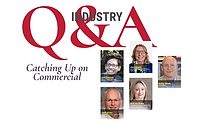Each year, GAF sets out to not only highlight the latest product innovations and contractor-benefitting programs its international staff develops and brings to market. The company also looks to send a message.
The ‘message’ made abundantly clear at the 2019 International Roofing Expo in Nashville — and throughout the first quarter of the year — is that the industry is changing. While most companies are bracing for change and the rapid influx of technology driving it, the world’s largest building materials manufacturer is showing that it isn’t afraid to evolve.
With the company’s first large-scale rebranding effort in decades underway, a new product line-up aimed at improving efficiency on the rooftop, and a new, unprecedented foray into the solar energy market, 2019 is proving to be a landmark year for GAF under relatively new but dynamic leadership.
RC had a chance to sit down with GAF President Jim Schnepper and ask him all about it from the 2019 IRE show floor.
RC: What’s your impression of the roofing industry in 2019?
JS: It’s healthy, and I don’t expect that to change. Where is it heading? It’s a great question…
I do know that it’ll be different than it looks today. Technology drives a lot of it from everything like making it easier and reducing the labor side, to what it takes to be more efficient to run a business.
RC: What excites you about the influx of technology into the industry?
JS: Technology is going to change the products that we manufacture, it’s going to change the methods in how we manufacture, and the products we put on people’s houses. Whether it’s solar or something else, I think we just have to be wise to it. The products in 10 years will probably look a lot different than they do today.
RC: Tell us about the major rebranding effort.
JS: So the rebranding effort is really about solving two things. One is the internal connection to the organization. We have really not had an image internally of what GAF means for the company. And it certainly wasn’t there for anyone on the outside, except for the high-quality materials that we manufacture. So we thought it would be a good idea to really connect somewhere emotionally with people and what it is we’re doing and want to accomplish with our company.
Two, it’s an emotional connection that we’re able to make about what it is that we stand for.
RC: What’s the message behind the new company tagline?
JS: What’s important about ‘We protect what matters most’ — as subtle as it sounds — is that everyone has a different answer to that. And so it can work internally and externally for our customers and our property owners who buy our products. For that reason, I think it’s brilliant.
RC: Why is 2019 the right time?
JS: What I really love about the result is that it gives kind of a look back traditionally at our brand but does it in a real contemporized way.
Taking our box and turning it into a frame and then saying we protect what matters most, and then put what matters most to you in that frame was briliant. And I love the idea, the concept, and like I said, it’s not forgetting the tradition of what we’ve stood for in the past.
2019 was year two of me heading the company and it was the right time because I felt the need to connect deeper really and give meaning to what we do as a company internally and what our customers could expect from us.
RC: Another announcement made before IRE is the GAF Energy initiative. Why is GAF in the energy business?
JS: We believe that solar has a place on every roof, and we would love to have that opportunity to present that idea to all the property owners out there in the U.S., and globally. That’s what we’re after, we think it’s just needs to be more democratized, easier to get and get your hands on, and easy for our contractors to install.
RC: Such a major move, what about the timing?
JS: The timing is a matter of feeling like it’s the right time. As you look at what our customers and property owners are saying, they’re all trying to find a way to see how solar could work for them, and if it would work for them. The interesting thing is that as old as solar is, there has to be a way for it to be easy for them to get, and it looks good on the properties and homes that they have.
You look across the number of rooftops across the U.S. it doesn’t take long to realize that ‘Wow! If you could actually generate power from that in a way that’s not intrusive into anyone’s life, that would be a great solution.”
RC:GAF stepped up in a big way in areas hardest hit by hurricanes in 2018. Tell us about the importance of storm response.
JS: We wanted to make sure we had a presence that said ‘here’s what we do, and we’re here if you need us. We’re a roofing manufacturer, and when hurricanes and devastation hits the U.S., and the markets where we live and operate and the people they live next to may be in need … we have to provide that need. We manufacture roofing, why wouldn’t it make sense that we provide those that can’t get it themselves and need it?
RC: How prepared do you feel for this storm season?
JS: I do believe we’re in a very healthy position to service the market from most major storms. We’ll probably service through the demand created by last year’s storms somewhere in the third quarter and I think we’re working those storm areas faster than we originally anticipated, and there should be sufficient capacity should there be another significant event in the industry.
RC: What are you personally hearing from roofing contractors about what keeps them up at night?
JS: It’s so funny, this hasn’t changed in the last three years and I could probably stretch it easily to five. But it’s labor and leads. The labor issue that you hear about in other industries as well is very real for the roofing industry. I think the path to solving labor is through all the manufacturers and the products that can install faster, quicker, easier and that reduces labor is something we have to consider. And then you have to consider technology and what technology can do to free up time for roofing contractors whether it’s on the front end of estimating what a roofing project will cost a homeowner or property owner, all the way up to how they’re paying their bills and collecting.
RC: How has GAF responded to the workforce challenge?
JS: We love training. We’ve had our Center for Advancement of Roofing Excellence (CARE) group for probably 10 years running. We love training contractors, and again, if you can help them do what they do, install better and faster, we’re in on that also. We’re a big proponent of it. We’ve had a certification program for over 20 years, which includes training, but the focus has been on training and helping our contractors. And to give them a certification level.
RC: Asphalt shingle sales for 2018 dipped or remained flat. Is there any concern?
JS: I think the natural roofing cycle is coming back to a normalized level. When I say that, I mean the industry on the product side for asphalt shingles, went from organic felt and strip shingles to inorganic glass felt and laminate shingles, and that extended the roofing life cycle. When that happened, we had this air in the pipeline so to speak that is just starting to clear.
So I think a normalized level of about 125-132 million squares of shingles sold a year is probably right and probably where the market settles in.
RC: What keeps someone in your position up at night?
JS: That someone else comes up with another product before I do that starts to replace the fatter part of the market, which is the asphalt shingle.
That’s got to be what keeps all of the asphalt manufacturers up at night. Right now it is still the most efficient way to waterproof your house, and it’s aesthetically pleasing, which is accepted. There’s nothing you can do that’s less expensive and looks as good as an asphalt roof today for that money. But something may come up and that’s what we worry about, and think about every day.
I think it’ll be some iteration based of the asphalt shingle: it may be a modifier that reduces the asphalt content, who knows what that looks like? We’re fervently looking for things and I know the industry overall is too.





